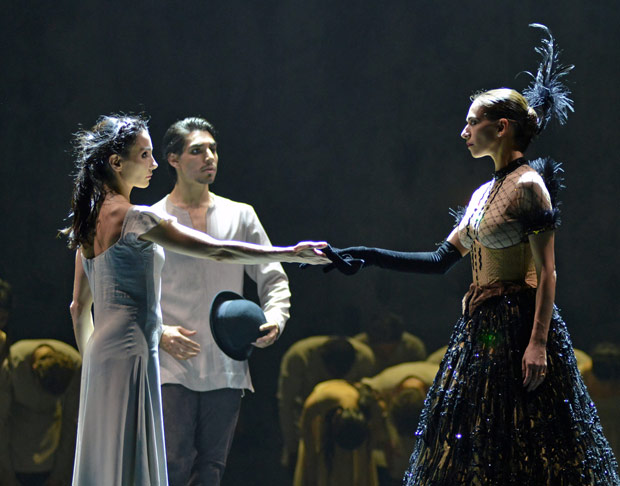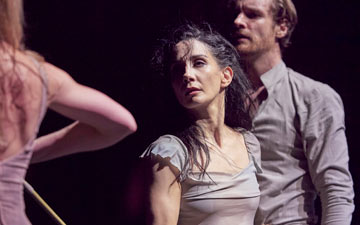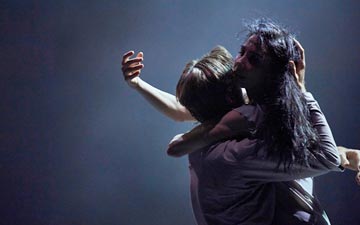
© Dave Morgan. (Click image for larger version)
English National Ballet
Giselle
★★★★★
London, Sadler’s Wells
20 September 2017
Gallery of pictures by Dave Morgan
www.ballet.org.uk
www.sadlerswells.com
Tamara Rojo’s artistic leadership of English National Ballet has been a steadily-building, slow-burning success, scorching her way through the particular landmarks of the last five years, such as in her Lest We Forget and She Said programmes; the former commemorating the centenary of the outbreak of WW1 (and introducing Akram Khan’s unique style of contemporary ballet through his contribution of Dust to that quadruple bill); the latter, an important celebration of new choreography, by women. The explosive outcome of this slow-burning fuse arrived with the premiere of Akram Khan’s Giselle, in Manchester, a year ago. An astounding success then, it has returned to open the ENB 2017/18 season in a revival with small revisions that have transformed it into an even greater success.

© Dave Morgan. (Click image for larger version)
The story remains essentially true to Théophile Gautier’s libretto for the great Romantic Ballet of 1841; a love letter for his beloved Carlotta Grisi (a one-way infatuation since Gautier married her sister, Ernestina). Khan’s environment switches from Middle-Age Rhineland to a grim, futuristic industrial setting; his inspiration derived from the conditions of modern slavery endured by women working in the sweatshop garment factories of Bangladesh, which he has evolved – through collaboration with his dramaturge (Ruth Little), designer (Tim Yip) and composer (Vincenzo Lamagna) – into an abstract, dystopian setting where dispossessed migrant workers have become playthings for the amusement of the popinjay landlords who have cast them out from their abandoned factories. Whether conceived in 1841 or 2016, both the Giselle of Gautier and Khan are essentially tales of brutal inequality.

© Dave Morgan. (Click image for larger version)
Yip’s set design revolves (literally) around a huge wall that represents a monumental and inaccessible barrier between the haves and have-nots. Initially, we see handprints on the wall, representing the outcast workers’ desperate attempts to claw their way back up and over the barrier. Midway through Act 1, the wall swings open as the Landlord (Fabian Reimair) and his entourage venture out for their evening’s entertainment, wearing outrageous, ostentatious costumes.
At each juncture, we see a resonance with the original narrative. The outcasts are the Rhineland peasants; while the Landlord and his “court” represent the Duke of Courland’s hunting party. The only character omitted from Khan’s reading is Giselle’s mother, Berthe. Exactly as in the original, Albrecht disguises himself as an outcast (peasant) to conduct his flirtation with Giselle, opposed by the suspicious and jealous Hilarion; and when Albrecht’s fiancée, Bathilde, arrives with the propertied elite, the grief-stricken Giselle, dies (although here, it seems more likely that she is killed on the Landlord’s command). Instead of being jilted brides, the Wilis are the spirits of factory workers who have died from industrial neglect, led – as always – by their Queen, Myrtha.

© Dave Morgan. (Click image for larger version)
The ENB ensemble brings a rich and expressive maturity to each of these characterisations. In Khan’s reading, as Giselle, Rojo eschews any air of vulnerability. Her pride and passion countermand the insecurity of her tenuous position as an outcast: she literally bridles with the pleasure of recognising her handiwork in Bathilde’s beautiful gown. James Streeter brings an unusual poignancy to his sensitive handling of the anguished Albrecht and his final duet with Rojo has an intensely arresting, emotional power.

© Dave Morgan. (Click image for larger version)
Nonetheless, these principal characters are less detailed in Khan’s interpretation, perhaps because the support roles of Hilarion and Myrtha are given greater credence. Hilarion dominates the first act as a go-between “fixer” – an agent for the landlords amongst the outcasts – and, in this role, within the first few minutes, Cesar Corrales demonstrates both his remarkable virtuosity and charismatic stage presence in a fluid, hyper-flexible solo, which prefaces several more bursts of athletic dance. As Bathilde, Begoña Cao exudes a poisonous cocktail of haughty authority and ice-cold beauty, wearing the most glorious of gowns, a body-hugging bodice offset by a flowing skirt. Praise also is due for the commanding presence of the bamboo-wielding corps of Wilis, led by the Amazonian authority of Stina Quagebeur, playing Myrtha as the most terrifying of Dracula’s brides. Altogether, this is a splendid cast.

© Dave Morgan. (Click image for larger version)
The runaway success of Akram Khan’s Giselle is due to the sum of all its constituent parts. Excellence is everywhere, topped off by Lamagna’s brilliant score, mixing orchestra, electronica, mechanical sounds, bells and silence with an unremitting, mesmerising and pulsating urgency. It builds, breaks away, and builds again; incessantly marching on, holding our attention, without wavering. It is utterly integral to the work’s soaring impact. The orchestra – under Gavin Sutherland’s command (Sutherland also orchestrated Lamagna’s score) – was equally magnificent.
Akram Khan has delighted audiences with his classical kathak repertoire, his collaborations with great artists from across the arts (Antony Gormley, Juliette Binoche, Sylvie Guillem, Sidi Larbi Cherkaoui and Israel Galván, to name but a few), some of which have fused genres together to create magical new hybrid dance forms. His latest trick is a production that seems destined to become a masterpiece of early 21st Century contemporary ballet.

















You must be logged in to post a comment.